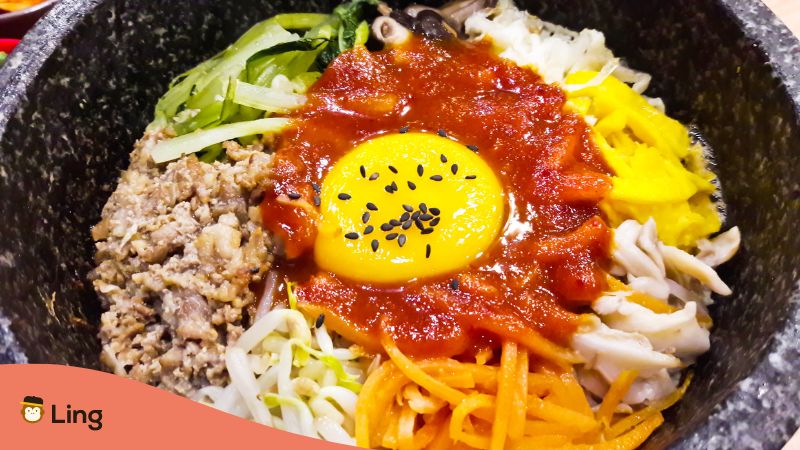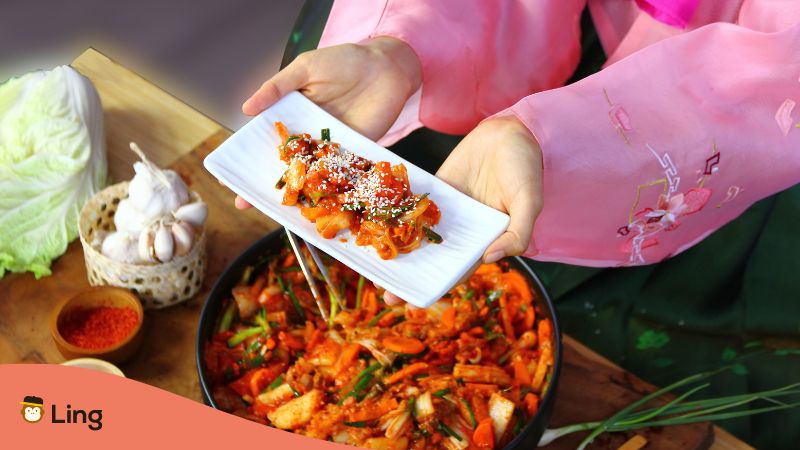Being one of the most popular cuisines today, people seek the mouthwatering flavors of Korean food. So, let’s learn different flavors in Korean 맛 (mat).
Have you experienced dining in a Korean restaurant? Well, brace yourself with flavorful and tasteful food. You’ll definitely not be going to put down your chopsticks because the food will already speak for itself.
South Korea is home to the delicious Samgyeopsal, Kimchi, Bibimbap, and more. What makes Korean cuisine different is the flavors, and food tastes that Koreans are known for. In fact, Korean food is a sign of how rich their culture is. So, in this blog, we will learn about words and phrases related to flavors in Korean, which you can use when you eat food with your Korean friends.
What Makes Korean Food Tasty?
They say that food is another way to express one’s culture and Korean food is definitely one of the evidence for this. Korean food has unique tastes compared to western food and other Asian countries like Japanese, Chinese, and Thai.
South Korean cuisine is explosively flavorful, blending fermented, preserved, and pickled flavors with scorching bursts of chili, creative vegetable preparations, and, of course, the grilled flavors that are distinctive from Korean cuisine.

Meat, particularly beef, is a big part of Korean cuisine. Barbecues and sauces with a stronger flavor are popular. Although rice is the most frequent grain, a variety of noodle recipes are popular in Korean cuisine. The pickling procedure known as kimchi is used to preserve vegetables. This method can be used to pickle practically any fresh vegetable, but cabbage is the most common.
Koreans cooking methods nowadays are not so different from what most cuisines use. Some of the methods that chefs in Korea use are stirfrying, braising, boiling, steaming, and grilling. But, even with the advancement of technology, they still maintain their traditional methods like fermenting. This is one of the factors that greatly affect Korean flavors. Korean flavors are distinct not just because of the methods but also the ingredients. In Korea, they use many ingredients in their food, making it flavorful.
Korean Words For Taste And Flavors
Korean restaurants and stores are everywhere. When you’re craving your favorite Korean food, you can easily get it from the stores, shopping malls, or order it online. If you really love Korean food, why don’t you learn some vocabulary about flavors in Korean?
The Korean word for flavor or taste is 맛 (mat), and you will learn more vocabulary below. If you want a fun way to learn this lesson and other lessons, you can visit Ling App. But for now, here are the different Korean flavors and taste that you should know.
1. 달다 (Dalda) – Sweet
Example Sentence: 이것은 매우 달아요 (Igeoseun maeu darayo) – This is very sweet.
The sweet flavor 달다 (dalda) in food is usually used for deserts. So, when we talk about Korean desserts, we have the songpeyon 송편, 松䭏 (Korean rice cakes), hotteok 호떡 (sweet pancake), and of course bingsu 빙수 (shaved ice). You might also be familiar with the bungeoppang 붕어빵 (Fish-Shaped Bread With Sweet Red Bean) that you mostly see in K-drams like in Reply 1988.
2. 시다 (Sida) – Sour
Example Sentence: 이 사과는 매우 셔요 (I sagwaneun maeu syeoyo) – This apple is very sour.
One of the common Korean flavors that you often taste in their food is the sour 시다 (Sida). It is often mixed with other tastes like sweet to make a Musaengchae 무생채 (sweet and sour radish salad) or spicy like how 김치 kimchi (chili pickled cabbage) tastes like. These side dishes are very important in a Korean meal.
3. 짜다 (Jjada) – Salty
- Example Sentence: 그의 수프는 매우 짜요 (Geuui supeuneun maeu jjayo) – His soup is too salty.
Most of the salty 짜다 (jjada) food is the fried foods like 만두 fried mandu (Korean dumplings), and Bindaetteok 빈대떡 (mung bean pancake). Salty 짜다 (jjada) seasonings can also be tasted in broths and soups. With this, we can say that salty flavor is really one of the Korean flavors that we usually taste when we eat Korean food.
4. 쓰다 (Sseuda) – Bitter
Example Sentence: 나는 쓴 커피를 좋아하지 않는다. Naneun sseun keopileul joh-ahaji anhneunda. – I don’t like bitter coffee.
We have been talking about Korean food for a while, and there’s a lot of Korean food that is bitter. But tI would like to use 소주 Soju as an example. It is a Korean alcoholic beverage that is usually partnered with Korean fried chicken.
5. 맵다 (Maepda) – Spicy
Example Sentence: 김치는 매워요. Gimchineun maewoyo. – Kimchi is spicy.
The Korean word for spicy is 맵다 (Maepda) for formal, 매워요 for casual. There are lots of spicy Korean food that we usually taste. To name some, we have the Korean fried chicken, Oi Muchim 오이무침 (Korean cucumber salad) and of course the very famous kimchi김치 (chili pickled cabbage). Spicy is one of the most common flavors in Korean cuisine.

Other Words To Describe Food In Korean
| Hangul (Korean) | Romanization | English Translation |
| 딸기 맛 | ttalgi mat | strawberry-flavored |
| 초콜릿 맛 | chokolit mat | chocolate-flavored |
| 맛있다 | masitda | delicious |
| 싱겁다 | singgeopda | bland |
| 차갑다 | chagapda | cold |
| 뜨겁다 | tteugeopda | hot |
| 질기다 | jilgida | tough |
| 부드럽다 | budeureopda | soft |
| 쫄깃하다 | jjolgishada | chewy |
| 바삭하다 | basakhada | crispy |
| 시원하다 | siwonhada | cool (Literal)/ refreshing/ soothing to the stomach |
| 구수하다 | gusuhada | savory taste from doenjang (fermented soybean paste) |
| 고소하다 | gosohada | nutty (describe the taste of sesame seeds, sesame oil, nuts, or soy milk) |
| 떫다 | tdeolpda | describe the taste of a persimmon (unripe) |
| 느끼하다 | neukkihada | to be greasy; an uncomfortable feeling when you eat very creamy or greasy |
Spice Your Life By Learning Korean
How many languages do you speak? Today, knowing just your native language is very unusual given how wide our horizons and opportunities in learning languages are. So, why not spice your life through learning Korean? The Ling app is the perfect app to help you learn Korean in record time. Have fun while learning the lessons through mini-games and quizzes. You can learn extensive grammar lessons and practice them in dialogues.
With the Ling app, learning languages is just a click away! Start learning Korean now!


















